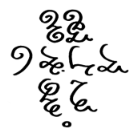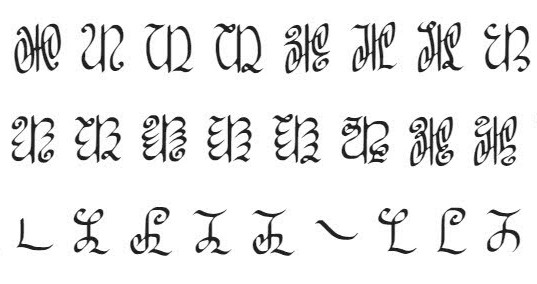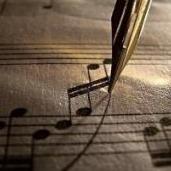-
Posts
196 -
Joined
-
Last visited
-
Days Won
7
Fugax Contrapunctus last won the day on April 9
Fugax Contrapunctus had the most liked content!
About Fugax Contrapunctus

- Birthday July 15
Contact Methods
-
Website URL
https://www.youtube.com/@fugaxcontrapunctus?sub_confirmation=1
Profile Information
-
Gender
Male
-
Occupation
Student
-
Interests
Composition, language learning, philosophy, conlanging and worldbuilding
-
Favorite Composers
J. S. Bach, Scarlatti, Beethoven, Mendelssohn, Brahms, Chopin, Tchaikovsky, Liszt, Mahler, Rachmaninov, Prokofiev, etc.
-
My Compositional Styles
Contrapuntal neo-Baroque
-
Notation Software/Sequencers
MuseScore 3 & 4
-
Instruments Played
Violin, piano
Recent Profile Visitors
5,733 profile views
Fugax Contrapunctus's Achievements
-
Greetings Henry. Indeed I had expected the similarities between the primary subject of BWV 1080 and the ones used here would end up seeming far too glaring. Perhaps it may serve as a testament to the versatile simplicity of this kind of subjects, whence far greater complexity may be properly built upon. In any case, another fair reminder of Bach's genius and the omnipresent influence of his fugal developments. With that out of the way, I must apologize for not replying sooner with regards to the recent calamity. I wholeheartedly hope none of your acquaintances were directly affected by the fire. I initially hesitated to properly dedicate it to the victims due to its magnitude and devastation, and especially because of the gruesome suffering, mourning, affliction and grief so many families and friends of the deceased must be going through, for which this humble composition of mine could never properly stand up to provide nearly enough consolation. However, I should have realized sooner that not acknowledging it at all would be far more insensitive and disrespectful towards the victims and their loved ones. As such, albeit rather late, the dedication has been included in the score document. My utmost condolences. 節哀順變。
-
And I thought those low D-sharps on the basses were far too excessive! I couldn't even bring myself to sing below a very awkward-sounding E despite technically being a baritone. I wonder how potent of a voice a deep bass singer must have for such a B-flat to be remotely audible as pitch instead of pure vibration. To me, such extended ranges seem far more extreme than the usual alto-contralto range, which I believed is usually cited to reach down to an F below the staff. In any case, the concern is understandable. This fugue was originally set for D minor, as much of a nod to Mozart's heavy association of death with this particular key as a matter of convenience in order to adhere to the standard ranges for vocal music, which as we know often tend to require more conservative estimates in choral settings. Unfortunately the digital choir soundbanks I'm using struggled far more just a semitone above in certain passages, with certain octave leaps in the tenor part sounding especially screechy, so in the end I was forced to choose the lesser flaw and thus had to resort to lowering the whole piece to its current key. I hesitate to even call it a double fugue, as what might appear as the 2nd subject is in fact merely derived from the first, and I certainly would not dare label it a triple fugue, despite the relatively minor changes undergone by the subject that would normally not be explained by a conventional tonal answer. The stretto treatment is undergone first by what could be considered the 2nd subject following its own development section, and only then does the stretto for the original subject come about, thus helping cement an overarching ABA' superstructure that unifies the piece as a whole beyond mere exposition, development, stretti and codae in cycling motion. As for the Christmas Music Event, perhaps I might be able to submit a proper piece before the deadline. As of lately I've been considering a 5-part motet rendering of "O Magnum Mysterium", though I may consider other related texts to the same effect. In any case, I'll let you know in the dedicated thread if I manage to finish anything suitable in time. Thank you for your review!
-
After undergoing plenty of struggle to find a proper textual setting capable of matching the rhythmic patterns of this vocal fugue, I decided to settle for an altered version of the "Libera me" movement commonly found on Requiem masses. Despite the minor changes required for the text to fit the subject of the fugue, its treatment throughout has been a conscious attempt to make it as audibly intelligible as possible, as opposed to the vast majority of my previous vocal works, where any regard for the text was completely secondary to the music. This composition, as well as its harrowing message, has been dedicated in memoriam to the victims of the Wang Fuk Court fire, which tragically befell Hong Kong on November 26th. May their souls find peace and eternal rest. 請安息吧! YouTube video link:
-
Wieland Handke started following Fugax Contrapunctus
-
Among all the other previously published canons of its type, this one might as well have turned out to be the most demanding to perform, in no small part due to the choir's conventional maximum ranges being reached in at least three voices, including both soprano (C6) and bass (E2), making it no small feat to sing. The main lyrics would roughly translate from Latin to English as follows: "In the direst of circumstances the true heart of men shall sing with great hope of leaving behind a memorable life. Even death can conquer those whose memory lies in the glory of their good deeds." The coda, as per usual, reinforces the core message in a variety of ways. YouTube video link:
-
- 1
-

-
As the third installment in my enharmonic perpetual canon cycle, this one follows a procedure nearly identical to that of the first one and is quite similar in duration as well. The lyrics (once again, in Latin) sung by the choir translate as follows: "Change is inevitable in all things. Everything flows in the balance of those who are tempestive." As with the previous installment, the coda further drives the meaning to greater clarity and realization. YouTube video link:
-
Based on the same core concept as the last two canons, this one took roughly under four hours to complete (as time seems to fly once I finally get inspired) and is intended to incapsulate the essential technique employed in these more recent compositions with a greater measure of brevity and conciseness involved, for perhaps three minutes of the same nonstop iterations (as was the case in the previous one) may have turned out quite a bit too repetitive, I regret. YouTube video link:
-
The basic framework for this canon has been in the works for more than a month now, as the technique I employed in the latest one in order to have all voices enter in every diatonic transposition of the same motif turned out to be contrapuntally insufficient. This time, in order to account for more viable ranges both in instrumental and choral settigs, I reduced the number of voices to 6, even though the core parameters still remain: every voice enters one fifth below the previous one, and instead of diatonic transpositions being treated as though in the same key, every transposition is essentially a real answer throughout, with the integrity of the main theme's melodic intervals kept intact. This entire setup (alongside certain variations when it comes to the disposition and order of entry of each voice so as to accommodate for the instrumental and vocal ranges of the woodwinds and the choir respectively) gives rise to a distinctly chromatic environment of constant modulation leading to a 2nd iteration of the same canon one tritone higher, at which point it keeps rising to meet the octave above and every voice alternates a divisi to prevent the melodies from climbing even higher and thus, yielding a perpetual canon (with a coda at the end for good measure). Lastly, the lyrics in Latin sung by the choir are intended as placeholders with thematic and allegorical significance towards the spirit of the canon itself: "Rosea surgit aurora, Sol fulget in caelo - Aurea cadens vesper stellarum tegit noctem", which would roughly translate to "Dawn rises rosy, the Sun shines in the sky. Evening falls golden, covering the night in stars." Not profound by any means, but simple enough to reflect the perpetual motion of the canon as an allegory for the unending passage of time. YouTube video link:
-
As stated in the title, this perpetual canon follows all diatonic intervals of the key of B-flat major, as every entry begins on a different degree of the major scale as a tonal transposition of the canon's theme. Since every voice enters while alternating between strong and weak beats as displaced accents, this canon could also be described as "per arsin et thesin", so to speak. Enjoy! YouTube video link:
- 1 reply
-
- 1
-

-

Canon a 4 for String Quartet in F minor.
Fugax Contrapunctus replied to Fugax Contrapunctus's topic in Chamber Music
Precisely because of the issues presented by the MuseScore 4 soundbanks I had to remove the cello's initial staccato. It made that single quarter note sound way too strong and became unwieldy when trying to get the playback functionalities to work properly. In any case, thank you kindly for all your feedback, including that which you gave for my other relatively recent compositions. -

Dodecaphonic Perpetual Canon for String Quartet.
Fugax Contrapunctus replied to Fugax Contrapunctus's topic in Chamber Music
Much to my wholehearted agreement, you already pointed this out in your review of my other dodecaphonic canon: "Although I have read from Taruskin's Music History book that counterpoint without tonality would be not too meaningful without the rules for dissonances and its resolution, but it is clearly not correct here. Given your ultimate care for preventing clashing dissonances, I find this one actually quite melodious and even tonal, or at least pan-tonal." In any case I don't find Taruskin's assessment entirely correct, just as you pointed out, since care for the clashing and resolution of dissonances need not necessarily be strictly derived from the rules of tonality, but instead out of the composer's own stylistic preference. One of the greatest things I have thus far found true for the dodecaphonic tone row system is that it allows for an immense amount of diversity when it comes to compositional approaches, which is specially true for stylistic notions of what works and doesn't in any given work according to the composer's own intrinsic judgement. In many regards I believe my usage and deployment of contrapuntal techniques to be the polar opposite of Schönberg's in terms of the treatment of dissonance, as in coining the term "emancipation of dissonance" so as to refer to his own proclivity towards unprepared and unresolved dissonances he was so proudly fond of, I believe he essentially stopped hearing dissonances as "ill-sounding" or unpleasant to the ear. For better or worse, my own particular stylistic preferences remain fairly attached to the etymologically quintessential definition of dissonance I just provided, independent of a tonal context. As such, my reticence towards unsing certain intervals has little to do with the standards conventions of tonal preparations and resolutions thereof, but with my own tendency towards finding intervals like minor 2nds and major 7ths quite distasteful to hear in clashing (though slightly more toolerable in suspensions), and also difficult to handle contrapuntally with my current bare-bones approach towards the general treatment of tone rows in my latest canons. -

Dodecaphonic Perpetual Canon for String Quartet.
Fugax Contrapunctus replied to Fugax Contrapunctus's topic in Chamber Music
That's certainly interesting. I actually find the piano version less enjoyable due to how mechanical the tempo ended up making it sound. Though the tempo change between both versions was intentional, I found it hard to slow it down even more lest the overall character of the piece turned way too stagnant for most preferences. Indeed, the moral tonal-sounding final cadence was supposed to generate both a sense of conclusiveness and overal contrast as a sort of referential "wink" towards tonality, much like the ones Alban Berg tended to include in many of his own dodecaphonic pieces. Lastly, thank you for your feedback as always. It's certainly quite refreshing to find out about other pespectives differing from my own on what my compositions may bring to mind this way, without the contrivances and condescending language I have rather occasionally had to endure from other users in this forum less accustomed to the basic etiquette constructive criticism usually demands. Thanks for everything. -

Fughetta in C minor for String Quartet.
Fugax Contrapunctus replied to Fugax Contrapunctus's topic in Chamber Music
Unfortunately, given how short this piece already is, such textural density isn't just merely accidental, but a properly deliberate design choice. Should the composition in question reach up to more than 3 minutes or so, as is the case for other compositions of such duration among my works, perhaps I would consider temporarily suppressing one or more of the given voices. Otherwise, unprompted rests in the middle are out of the question for me. Fixed, and thank you for your kind words, as well as your constructive feedback. -
The name of the program in question is Cantāmus (https://cantamus.app/), a music rendering website originally intended for vocal rehearsals, but which serves my purpose of setting my vocal works with actually "sung" lyrics well enough, so to speak. Better yet, it doesn't even work with MIDI, as it reads the score directly once uploaded to the site as a .musicxml file (which I find rather optimal, given my own bad experiences and failures in trying to get MIDI exports of my compositions to be relatively decent). I also often tend to overlay the final recording of the Cantāmus rendering with the audio file for my composition as sung by the MuseScore 4 MuseSounds Choir soundbank afterwards using Audacity, so as to grant the otherwise crisp and dry timbre of the Cantāmus voices a softer, more mellow sound and a greater sense of reverb.
-
A slightly more Romantic-sounding fugue than usual, whose theme's chromatic nature I chose to exploit with a string quartet setup for greater expressive intensity. The subject itself was originally somewhat experimental in nature but quickly developed into a full-fledged exposition, and the rest was hours upon hours of trying to deal with its rather unwieldy nature as best I could. Enjoy! YouTube video link:


.thumb.png.8b5b433a341551e913a34392660bc95b.png)




.thumb.png.1e2763f479362bbb522da50d31ef2e50.png)




